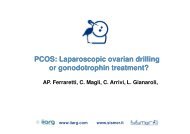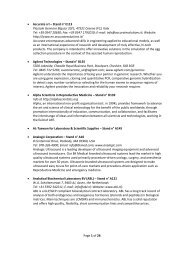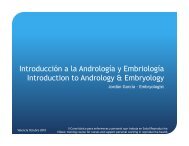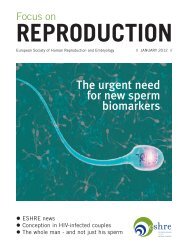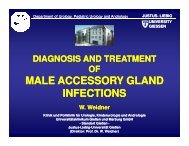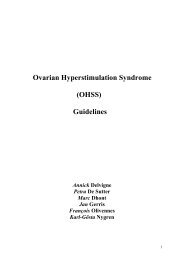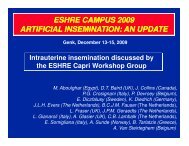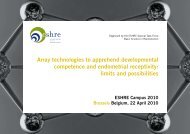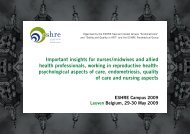Dr Kirsty Dundas Consultant Obstetrician and Gynaecologist ... - eshre
Dr Kirsty Dundas Consultant Obstetrician and Gynaecologist ... - eshre
Dr Kirsty Dundas Consultant Obstetrician and Gynaecologist ... - eshre
Create successful ePaper yourself
Turn your PDF publications into a flip-book with our unique Google optimized e-Paper software.
<strong>Dr</strong> <strong>Kirsty</strong> <strong>Dundas</strong><br />
<strong>Dr</strong> <strong>Kirsty</strong> <strong>Dundas</strong><br />
<strong>Consultant</strong> <strong>Obstetrician</strong> <strong>and</strong> <strong>Gynaecologist</strong><br />
Royal Infirmary of Edinburgh <strong>and</strong> University of<br />
Edinburgh
Cervix Role<br />
Menstrual flow<br />
Passage semen/capacitation<br />
Maintain fetus<br />
Mechanical<br />
<br />
<br />
Even first trimester decreases strength <strong>and</strong> increase in canal<br />
diameter (Johnstone)<br />
By 28 weeks shortening occurs in normal pregnancy<br />
Anti-bacterial by the operculum<br />
Rapidly dilate/shorten<br />
decrease collagen, increase water, inflammatory role
Cervix Structure<br />
Isthmus /Corpus/cervix<br />
Danforth 1947<br />
Uterus is two parts with abrupt change<br />
<br />
<br />
corpus chiefly muscular<br />
cervix chiefly fibrous<br />
Stroma is collagen which confers rigidity<br />
embedded in ground substance<br />
Small amount elastin component<br />
Muscle component<br />
Progesterone inhibits collagenase (Jeffrey et al)
Cervix structure <strong>and</strong> role<br />
Mechanical role<br />
Hormonally influenced<br />
Susceptible to inflammatory effect including infection<br />
complex
Insufficiency/incompetence<br />
Inability to retain a<br />
pregnancy in the<br />
absence of contractions<br />
or labour.
Cervical<br />
Incompetence/Insufficiency<br />
Controversial<br />
Aetiology obscure<br />
Maybe congenital or acquired deficiency<br />
Difficult to diagnose<br />
After poor outcome
Uterine Anomaly association<br />
Arcuate – no<br />
Unicornuate<br />
1/3 preg end in miscarriage<br />
Increase CS rate<br />
No clear evidence<br />
Uterus didelphys<br />
67% two vaginas, thin wall<br />
Usually two cervices<br />
20% misc, 24.4% PTL, increase CS – dystocia/malpres<br />
Bicornuate –up to 55% incidence CI(Golan)<br />
DES – 50% structural cx defect, hypoplastic
Diagnosis<br />
History<br />
Recurrent midtrimester loss/preterm birth<br />
Classical painless dilatation <strong>and</strong> effacement<br />
No infection, bleeding, preterm rupture membranes<br />
Cervical resistance studies<br />
No resistance to passage of 9mm Hegar dilator<br />
Low Cervical resistance index<br />
USS effacement <strong>and</strong> funneling<br />
screening<br />
Coincidental findings<br />
HSG<br />
Light induced fluorescence
Cervical Resistance Studies
Cervical Resistance Score<br />
Calder <strong>and</strong> Anthony. Euro J Obs & Gynae & Repro<br />
Biol.134(2); 174-8 2007<br />
175 Women ≥1 mid trim loss compared with 123 gynae<br />
6 Dilators from 3-8mm, read resistance score<br />
Median CRI 17 versus 38.26 Newtons<br />
<br />
62(35%) variance with history<br />
Cerclage in group affected with history <strong>and</strong> low CRI<br />
(
USS Measurement
USS (Berghella BJOG 2009)<br />
Cervical length by TV USS predicts preterm birth<br />
One off test at approx 16- 22 weeks<br />
Light induced Fluorescence<br />
Collascope<br />
Non-invasive measurement using LIF to assess cx<br />
ripening by measuring the natural flourescence of non-<br />
soluble collagen<br />
Low in cervical insufficiency<br />
Predicitve of time to delivery interval
Treatment<br />
Observation<br />
Bed rest<br />
Suture<br />
McDonald<br />
Schirodkar<br />
Transabdominal<br />
<br />
Laparoscopic<br />
Masterly inactivity
Cerclage<br />
Schirodkar 1955<br />
Initially emergency, later elective<br />
Indications remain unclear
McDonald Suture
Schirodkar Suture
Trans-abdominal Cerclage<br />
Timing<br />
Pre-preg<br />
Intra-preg
Laparoscopic Transabdominal<br />
Cerclage<br />
Mingione et al. 2009. 18(8):1716: Human Reproduction<br />
<br />
11 patients had interval procedure<br />
One case was DES exposure<br />
One small intestine injury<br />
Mean EBL 40ml<br />
10 patients have conceived 12 pregnancies<br />
<br />
<br />
<br />
2 8week miscarriage<br />
2 CS at 34 weeks<br />
8 ELCS at 38 week or more
Other features<br />
Timing<br />
Indomethacin<br />
Antibiotics
Evidence<br />
Cochrane Collaboration<br />
MRC/MRCOG trial<br />
CIPRACT<br />
Uterine anomaly evidence
General Evidence<br />
MRC/MRCOG Working Party 1993<br />
1292 women obstetricians in equipoise<br />
R<strong>and</strong>omised – cerclage or not cerclage<br />
PTL 26% versus 31%<br />
Delivery
General Evidence 2<br />
Cochrane<br />
6 trials<br />
2175 women – hx or CRI<br />
4 – prophylactic cerclage v no cerclage<br />
<br />
<br />
<br />
No reduction in preg loss/PTL<br />
Small reduction in births under 33 weeks<br />
SE of mild pyrexia, tocolytics, hospital admissions<br />
2- cerclage in short cx<br />
no reduction in loss/preterm delivery
Evidence in uterine anomalies 1<br />
Heinonen PK et al. Acta Obstet Gynecol Sc<strong>and</strong> 1982:Vol<br />
61(2); 157-62.<br />
182 women over 18 years<br />
126 had 265 pregnancies<br />
<br />
<br />
<br />
66% fetal survival<br />
8%PNM<br />
23% PTL<br />
Outome<br />
Complete septate 86% survival<br />
Complete Bicornuate 50%<br />
Complete unicornuate 40%<br />
Cerclage mostly applied in partial bicornuate<br />
53% fetal survival before op/100% after
Evidence 2<br />
Seideman et al. Surg Gynecol Obstet 1991;173:384-6.<br />
Observational<br />
86 pregs in ut anomalies (67 cerclage)<br />
106 pregs in structurally normal (29 cerclage)<br />
<br />
23% HSG proven CI in both groups<br />
88% of cerclage had viable baby v 47% non cerclage<br />
No benefit in normal group
Evidence 3<br />
Golan et al. Int J Fertility 1990 May- June;35(3):164-70<br />
98 women with uterine anomaly<br />
29 CI on HSG (30%)<br />
<br />
Bicornuate group 55% CI<br />
Overall 68% preterm labour/miscarriage<br />
Post suture<br />
Term delivery increase 26% to 63%<br />
Conclusion: all women with a bicornuate uterus<br />
should have cervical cerclage <strong>and</strong> all women with uterine<br />
anomaly should be considered for cerclage
Case history JR 2009<br />
Para 0+2<br />
12/40 miscarriage 2006<br />
7/40 MTOP 2007<br />
Never had a smear<br />
BMI 20<br />
Generally well<br />
Booked at 13/40: bicornuate uterus, viable pregnancy<br />
in left uterine horn
Case history 2<br />
20/40 referred to <strong>Obstetrician</strong><br />
Clinically cervix long <strong>and</strong> closed<br />
Plan USS at 22 weeks<br />
21+6/40<br />
USS shows cx is 16 mm closed<br />
Options discussed<br />
Returns for transvaginal cervical McDonald cerclage<br />
No evidence infection<br />
28/40 USS shows GM normal
Case history 3<br />
34/40 tightening <strong>and</strong> bleeding<br />
Suture removed<br />
Cx long <strong>and</strong> only fingertip dilated<br />
3cm effaced defect to right of cx os with bulging<br />
membranes<br />
35/40 rapid labour, HFFD DOP under pudendal<br />
Delivered through the defect<br />
EUA in theatre “bucket h<strong>and</strong>le tear”<br />
2.43Kg A <strong>and</strong> W.
Case history 4<br />
What next time?
Best advice<br />
Women with >2 pregnancy losses or preterm labour<br />
should have suture<br />
Women with a uterine anomaly but no previous losses<br />
should be monitored with USS.<br />
Consider cervical resistance studies<br />
RCTs needed
Current Research<br />
Prof Andrew Shennan
MAVRIC<br />
Contact: Prof Andrew Shennan<br />
E-mail: <strong>and</strong>rew.shennan@kcl.ac.uk<br />
Contact: <strong>Dr</strong> Manju Ch<strong>and</strong>iramani<br />
E-mail: manju.ch<strong>and</strong>iramani@kcl.ac.uk Top




